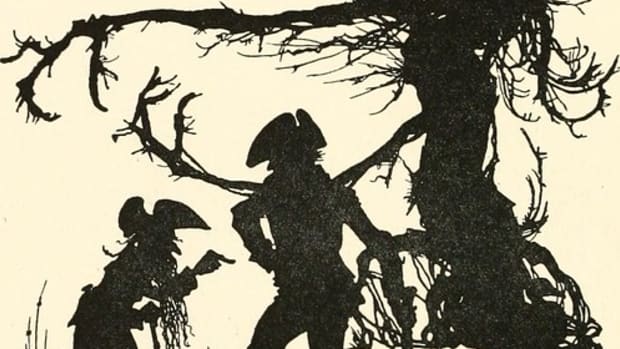Hangman's Rope & the Tyburn Tree: Folklore of the Gallows

Pirates, smugglers and mutineers were marched past the Tower of London on their way to the execution dock at Wapping.
Few things are as chilling as a gallows creaking in the wind - perhaps it was inevitable that a body of folklore would spring up surrounding the scaffold. This article covers the following facts and legends of the grisly gallows:
- A brief history of hanging, including a thrice-hanged man
- The hand of glory, cut from a corpse on the gallows
- Lucky lockets made with hangman's rope
- The brutal and bungling executioner Jack Ketch
- The mysterious Monsieur de New York
- The grim Tyburn Tree in London
A Brief History of Hanging
Hanging was a common method of execution in the Middle Ages, but it dates back much further. It appears in Homer's Odyssey, a poem from around 700 BC. In Europe, it was mainly spread by the Angles, Jutes and Saxons during the fifth century - Rome and Britain supposedly adopted the method thanks to their influence.
The gallows (derived from a Germanic word for pole or branch) was the structure used to hang the condemned. The simplest design resembles an upside-down L-shape, but other versions exist, such as a T-shaped double gallows. The gallows could also serve as a gibbet (a structure where the body is kept for public display), though separate gibbets also existed.
Early forms of hanging tended to kill via asphyxiation - the rope would cut off air supply, leading to the victim being strangled to death. This left the possibility of someone being revived after being "executed" in some cases.
The "standard drop" introduced in 1866 and the "long drop" of 1872 moved the cause of death to a broken neck. Known as a cervical or hangman's fracture, further victims were only spared if the gallows malfunctioned. One such man was John ‘Babbacombe’ Lee, an accused murderer who experienced three failed hangings before his sentence was commuted to life imprisonment.
The Hand of Glory
One superstition attached to hangings was that of the "hand of glory." This supposedly magical talisman was prepared using the right hand of a hanged criminal. The hand was thought to attempt to continue the misdeeds of life by helping further crimes.
The hand had to be cut from the body while it was still on the scaffold, then pickled. Accounts differ as to how it was used - in some cases, the fingers were folded around a candle of human fat, while in others they served as the candles themselves.
Lighting the candle or candles activated the powers of the hand - depending on the legend, it might reveal anyone awake in a residence, or prevent sleeping people from being roused. The powers lasted until the flames burnt out or were doused in "blue" (skimmed) milk.
Hangman's Rope
Another bit of magic associated with hangings was tied to the rope. Lengths of the hemp were said to be empowered by the death of the condemned, bringing luck and good health to those who carried them.
Though the idea may seem insane to us, the belief that an executed convict could intercede on behalf of people was pretty common in the 19th century. Lockets containing hangman's rope were available to the public, and some executioners were able to make a tidy side hustle selling portions of the used hemp.
The expression "carry a rope in their pocket" alludes to using hangman's rope as a good luck charm when gambling.
Recommended
Jack Ketch
One of the most (in)famous executioners was Jack Ketch. Operating in the 17th century, Ketch carried out hangings, quarterings and beheadings until he gained notoriety for a pair of horribly botched executions. Before then, Ketch cultivated a grim reputation - he was even able to go on strike, negotiating the right to sell bits of used rope.
His name entered English slang, where a noose could be called "Jack Ketch’s Necklace." He executed hundreds of people over his 12-year stint, mostly by hanging. Those considered traitors were also quartered, preserved and displayed to the public - Newgate prison actually named the room used to boil the body parts in pitch "Jack Ketch's Kitchen."
Though Ketch killed hundreds, it was a pair of botched beheadings that stuck in the public eye. It took Ketch four swings to decapitate Lord William Russell, leading him to write an apology to the crowd. Worse still was the execution of the Duke of Monmouth. Monmouth gave Ketch six guineas for a clean death, but he attempted the execution with a blunt axe.
The first blow did so little damage that the Duke raised his head off the block to protest. At four swings, Monmouth was still alive and convulsing. More swings and a butcher's knife were required to finish the job - Ketch nearly found himself lynched by the crowd.
Monsieur de New York
The USA had its own celebrity of the gallows, a mystery man working under the title "Monsieur de New York." The moniker was actually a reference to a dynasty of Parisian executioners who operated as the "Monsieur de Paris."
The origins, nature and identity of the man are shrouded in mystery - though he seems to have spent time as a sailor, where he learned a lot about rope and pulleys. Newspapers often referred to him as George W. Isaacs, which may or may not have been a pseudonym. A carpenter called Joe Atkinson would later claim to be the executioner ... he may well have taken over after the death of Isaacs.
What we do know is that the Monsieur viewed hanging as a science, acting as both engineer and executioner. Credited with designing new forms of gallows (and all too eager to test those new designs), his enthusiasm was somewhat disturbing. Combined with his reputation for showmanship and spectacle, one can't help but wonder what outlet he would have found for this obsession if not employed as a hangman.
The Tyburn Tree
Situated in London, a simple stone marker is all that remains of the "Tyburn Tree." What's so special about a tree? Well, it wasn't a tree at all, but rather a multi-limbed gallows where public executions were carried out in front of thousands-strong audiences. The tree was a triangular scaffold that could hold 24 simultaneously, erected on a site where the condemned had been executed for 600 years.
In standard English fashion, plenty of slang terms grew up around the device - from the simple "triple tree" to the "the deadly never green Tyburn Tree." Actually hanging was said to be "dancing the Tyburn jig."
The condemned stopped at two inns on the journey from Newgate prison, having a drink to steady their nerves. They were allowed to interact with the public somewhat - those who cracked jokes tended to be well thought of by the crowd, as were those who put up a fight against the hangman when the time came.
The condemned were allowed to speak a few words before their death - often used to criticise the authorities who condemned them. This tradition still exists in the form of Speaker's Corner, a section of Hyde Park set aside for protests.
This content is accurate and true to the best of the author’s knowledge and is not meant to substitute for formal and individualized advice from a qualified professional.



















